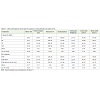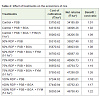Research Article
Effect of Phosphorus Levels and Bio-Organic Sources on Growth and Yield of Rice (Oryzasativa L.)
R. K. Meena, M. P. Neupane* and S. P. Singh
Corresponding author: M. P. Neupane, Assistant Professor, Tribhuwan University/ Institute of Agriculture and Animal Sciences, Lamjung Campus, Sundar Bazar, Lamjung- Nepal,; E-mail: mpneupane66@gmail.com
Citation: Meena RK, Neupane MP, Singh SP. Effect of Phosphorus Levels and Bio-Organic Sources on Growth and Yield of Rice (Oryza sativa L.). Indian J Nutri. 2014;1(1): 105.
Copyright © 2014 M. P. Neupane et al. This is an open access article distributed under the Creative Commons Attribution License, which permits unrestricted use, distribution, and reproduction in any medium, provided the original work is properly cited.
Indian Journal of Nutrition | Volume: 1, Issue: 1
Submission: 24/11/2014; Accepted: 01/12/2014; Published: 03/12/2014
Abstract
A field experiment was conducted during rainy season of 2013 at Agricultural Research Farm, Institute of Agricultural Sciences, Banaras Hindu University, Varanasi to evaluate the effect of phosphorus levels and bio-organic sources on growth and yield of wetland rice cv. HUR-105. Factorial experiment was laid out in Randomized Complete Block Design involving four levels of phosphorus viz. control, 50% RDP, 75% RDP and 100% RDP and three bio-organic sources i.e. PSB, PSB + BGA and PSB + BGA + FYM (5 t ha-1) replicated thrice. Increase in the levels of phosphorus application up to 100% RDP (60 kgP2O5 ha-1) improved growth attributes, yield attributes, grain and straw yields. Combined use of PSB + BGA + FYM (5 t ha-1) proved superior to PSB alone & PSB + BGA. Economic analysis indicated that integration of moderate phosphorus level (75% RDP i.e. 45 kg ha-1) along with the use of PSB + BGA + FYM (5 t -1) gave highest net return and B:C ratio.
Keywords: Phosphorus levels; Bio-organics; FYM; BGA; PSB; Rice
Introduction
Rice is one of the most important staple food crops in India grown on 44.01 million hectares with a total production of 105.30 million tonnes and an average productivity of 23.93 q ha-1 [1]. Present rice productivity is not enough to feed ever increasing population of this country thus, the only alternative left is vertical increase in yield since expansion of area is not possible. Integrated nutrient management in wetland rice is a needed strategy involving conjunctive use of chemical fertilizers & bio-organic sources for realization of potential yield on ustained basis. Farmyard manure or compost and use of blue greenalgae in wetland rice are the common practices [2]. Phosphorus is a major component in ATP, the molecule that provides energy to that plant for such processes as photosynthesis, protein synthesis, nutrient translocation, nutrient uptake and respiration [3]. Slow mobility of applied phosphorus and its marked fixation results in low crop recoveries in the order of 20-25%. Phosphate solubilizing bacteria (PSB) solubilize and mineralize the residual or fixed phosphorous, increases phosphorus availability in the soil and also the overall phosphate use efficiency [4]. Indian farmers are unable to afford the heavy expenditure on chemical fertilizers however, it is imperative to use technologies such as phosphorus management in an integrated manner for its increased use efficiency. The present investigation was carried out with a view to evaluate the effect of phosphorus levels and bio-organic sources on growth and yield of wetland rice under conditions of eastern Uttar Pradesh to suggest any suitable pattern for integrated management of phosphorus.
Materials and Methods
An experiment was conducted during rainy season of 2013 at Agricultural Research Farm, Institute of Agricultural Sciences, Banaras Hindu University, Varanasi to study the Effect of phosphorus levels and bio-organic sources on growth and yield of rice (Oryza sativa L.) under eastern Uttar Pradesh conditions. Factorial experiment was laid out in Randomized Complete Block Design with four levels of phosphorus viz. control, 50% RDP, 75% RDP and 100% RDP and three bio-organic sources i.e. PSB, PSB + BGA and PSB + BGA + FYM (5 t ha-1) replicated thrice. Recommended dose of fertilizers (RDF) used was N2-P2O5-K2O (120-60-60 kg ha-1). Half of the recommended dose of nitrogen and full dose of potassium were applied as basal application and remaining half nitrogen was applied in two equal splits at active tillering and panicle initiation stages uniformly to all the treatments. Variable rates of phosphorus were applied as per treatment. The experimental field was sandy clay loam in texture with pH 7.35, low in available organic carbon (0.39%), available nitrogen (198.03 kg ha-1), and medium in available phosphorus (23.7 kg ha-1) and potash (188.32 kg ha-1). Four week old seedlings cv. HUR-105 was transplanted on the puddled field keeping two seedlings hill-1 at a spacing of 20 cm × 15 cm. Blue green algae (BGA) was applied @ 10 kg ha-1 in their respective treatments at 10th day after transplanting. Before transplanting, seedlings were treated by root dipping in PSB solution for 30 minutes followed by transplanting. Required quantity of well decomposed FYM was applied basally as per treatments. Rainfall received throughout the crop period was 825.0 mm and about ± 5 cm water level was continuously maintained till flowering then after field was kept under saturated condition. Recommended agronomic practices were followed to raise the experimental crop. The data recorded were analyzed following standard statistical analysis of variance procedure as suggested by Gomez and Gomez [5].
Results and Discussion
Yield attributes
The yield attributing characters viz. number of tillers hill-1, panicle length, number of panicles m-2, number of grains panicle-1 and 1000 grains weight increased significantly with increase in the levels of phosphorus up to the maximum level of 100% RDP except at harvest stage where 50%, 75% and 100% RDP were found at par in producing number of tillers hill-1 and phosphorus levels, 0% & 50% RDP and 50% & 75% RDP were found statistically at par in producing number of panicles m-2 and number of grains panicle-1 respectively. However, treatment control (0% RDP) recorded 1000 grains weight on par with the treatment (50% RDP) but these treatments produced significantly lower 1000 grains weight as compare to 75% RDP and 100% RDP and which remain at par with each other. Ishizuka [6] opined that phosphorus plays an important role in the translocation of assimilates to the panicles and also as a constituent of protoplasm. This explains the reason for the increased length of the panicle, panicle weight and number of grains per panicle.
Application of bio-organic sources had noticeable influence on yield attributes and conjunctive use of PSB + BGA + FYM (5 t ha-1) produced highest number of tillers hill-1, panicle length, number of panicles m-2, number of grains panicle-1 and 1000-grains weight which was significantly superior than application of PSB alone and it remained statistically at par with the PSB + BGA in case of panicle length and 1000-grains weight. Magnitude of increase in number of panicles m-2 over PSB or PSB + BGA was 10.55% and 5.86%, respectively. Yield attributes of rice closely confirms the finding of Yogesh et al. [7].
Grain & Straw yield
The highest grain yield (50.97 q ha-1) was recorded with the application of 100% RDP which exhibited a superiority of 19.67, 13.11, 2.12 per cent over 0, 50 and 75% RDP, respectively. Addition of 100% RDP to rice crop at par with 75% RDP but both were significantly superior over 50% RDP and control treatment. Maximum straw yield was registered under application of highest phosphorus level (100% RDP) closely followed by 75% RDP and 50% RDP respectively. However, increase in level of phosphorus from 50% RDP to 100%RDP could not exhibit significant effect on straw yield and the above treatments were observed significantly superior only to control treatment (Table 1).
Combined application of PSB + BGA + FYM (5 t ha-1) recorded the maximum grain yield (49.27 q ha-1) which was significantly superior to other bio-organic sources. However, difference between treatments PSB and PSB + BGA was not significant. Maximum straw yield was noted with the combined use of PSB + BGA + FYM (5 t ha-1) which proved significantly superior to application of PSB alone but found statistically at par with PSB + BGA. Increase in grain and straw yield might be due to higher photosynthetic activity because of increased leaf area index, which ultimately promoted dry matter production resulting higher grain and straw yield. Quyen et al. [8]also reported similar results. The interaction effects between two factors were found non-significant in respect of yield attributes and yield.
Economics
A perusal of the data (Table 2) clearly indicates that cost of cultivation, gross return, net return and benefit: cost ratio increased with increasing levels of phosphorus as well as due to integration of bio-organic sources. Maximum cost of cultivation (` 38350.94) and gross return (` 85109.37) obtained with 100% RDP + PSB + BGA + FYM (5 t ha-1). Net return and B: C ratio exhibited the same trend due to integration of phosphorus level with bio-organics only up to 75% P level while net return (` 47288.00) and benefit: cost ratio (1.26) was maximum under integration of phosphorus level of 75% RDP with PSB + BGA + FYM (5 t ha-1) followed by higher phosphorus level (100% RDP) in combination with PSB + BGA + FYM (` 52076.85).
On the basis of above findings and economical analysis it may be concluded that the integration of moderate phosphorus level (75% RDP i.e. 45 kg ha-1) along with the use of PSB + BGA + FYM (5 t ha-1) proved most remunerative for rice variety HUR-105 under easternUttar Pradesh conditions.
References
- Anonymous (2011) Directorate of Economics and Statistics, Department of Agriculture and Co-operative, Ministry of Agriculture, Government of India, New Delhi.
- Begum ZNT, Mandal R, Islam MS (2009) Effect of blue-green algae and urea-N on growth and yield performance of traditional variety of rice. Journal of Phytological Research 22: 211-214.
- Wilson CE, Bollich PK, Norman RJ (1998) Nitrogen application timing effects on nitrogen efficiency of dry-seeded rice. Journal of Soil Science Society of America 62: 959-964.
- Chhonkar PK, Tilak KVBR (1997) Bio-fertilizers for sustainable agriculture: Research gaps and future needs. In Plant Nutrient Needs Supply, Efficiency and Policy Issues: 2000-2025 (Eds. J.S. Kanwar and J.C. Katyal). National Academy of Agricultural Sciences, New Delhi: 52-66.
- Gomez KA, Gomez AA (1976) Statistical procedures for Agricultural Research, (2nd Ed. 1984), John Willey and Sons Inc. New York, USA..
- Ishizuka Y (1971) Physiology of rice plant. Advances in Agronomy 23: 241-315.
- Yogesh TC, Viswanath AP, Thimmegowda P (2013) Yield and economics of aerobic paddy with application of zinc, iron and microbial inoculants. Journal of Environmental Sciences, Computer Sciences and Engineering & Technology 2: 100-104.
- Quyen NV, Sharma SN (2003) Relative effect of organic and conventional farming on growth grain quality of scented rice and soil fertility. Archives of Agronomy and Soil Sciences 49: 623-629.


